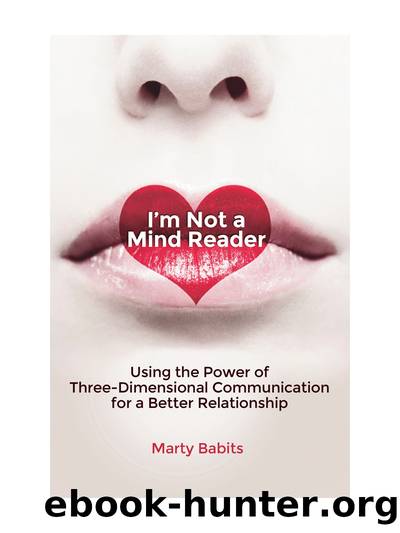I'm Not a Mind Reader by Marty Babits

Author:Marty Babits
Language: eng
Format: epub
Tags: use, using, power, three-dimensional, communication, better, relationship, relationships, mind, reader, book, books, marty babits
Publisher: Health Communications, Inc.
Published: 2015-04-07T00:00:00+00:00
Deep Communication
How do you go about creating the conditions that will allow your partner to feel he is being heard? That is what this exercise is designed to help you do. First, Iâll define two aspects of the most common conflict situations I encounter in my work. Most couples think that these aspects are the most important features of their dialogue and want to work them out in detail. I am going to help you define these aspects and then ask you to set them aside as we consider other features of the dialogue that, in fact, merely camouflage the aspects that offer us the greatest chance to build emotional safety. What I hope to do in this exercise is help you uncover what these are. Prepare to tolerate a mild amount of confusion as you figure out where we are headed. The path will become very clear in a short period of time. And when it does, the result will be worth the effort.
First, think of a situation in which you and your partner do not see eye to eye. Describe the disagreement in neutral terms. Do not explain or justify your point of view here, simply describe the issues at hand.
_______________________________________________________
_______________________________________________________
I will refer to your description of the disagreement as Part A.
Now jot down the reason(s) you feel your perspective is correct and your partnerâs is flawed.
_______________________________________________________
_______________________________________________________
Iâll refer to your understanding of the essence of why you feel your perspective is correct and your partnerâs is flawed as Part B.
The key point for this exercise is that neither Part A nor Part B is crucial to what is necessary for overcoming this disagreement and integrating it into a three-dimensional dialogue!
How you listen and respond to each other is critical.
Leave Part A and Part B on the side as you work through this exercise.
Consider Parts A and B as distractions from the task at hand, which is to create emotional safety. If for any reason at this point you feel like you would be unable to do that, express the reasons why this would be difficult for you below:
_______________________________________________________
_______________________________________________________
_______________________________________________________
If you have written anything I will refer to that statement as Part C.
Many partners have reasons they cannot proceed in learning how to conduct a nonjudgmental dialogue with their partners. For the purposes of this exercise, it is necessary that you release yourself from the obligation of identifying with Parts B and C. After the exercise is over, of course, you can reclaim them. To benefit, please put them aside for the moment if you can.
Summary:
Part A = description of the disagreement
Part B = the reason(s) you feel you are correct and your partnerâs perspective is flawed
Part C = the reason(s), if you have any, why you feel it would be impossible to talk about the disagreement without bringing up the fact that your perspective is right and your partnerâs is wrong
So now imagine that you invite your partner to describe how he feels about this issue. It is important that he understands that you are not asking him to engage in a debate with you.
Download
This site does not store any files on its server. We only index and link to content provided by other sites. Please contact the content providers to delete copyright contents if any and email us, we'll remove relevant links or contents immediately.
The 5 Love Languages: The Secret to Love That Lasts by Gary Chapman(9687)
Doing It: Let's Talk About Sex... by Hannah Witton(9233)
Should I Stay or Should I Go? by Ramani Durvasula(7621)
The Road Less Traveled by M. Scott Peck(7552)
The Lost Art of Listening by Michael P. Nichols(7450)
Daring Greatly by Brene Brown(6471)
Beartown by Fredrik Backman(5665)
We Need to Talk by Celeste Headlee(5569)
Men In Love by Nancy Friday(5191)
The Rules Do Not Apply by Ariel Levy(4905)
The State of Affairs by Esther Perel(4687)
How To Win Friends and Influence People by Dale Carnegie(4469)
Reflections Of A Man by Mr. Amari Soul(4257)
Pillow Thoughts by Courtney Peppernell(4237)
The Ethical Slut by Janet W. Hardy(4208)
Algedonic by r.h. Sin(4034)
Surrounded by Idiots by Thomas Erikson(3893)
He's Just Not That Into You by Greg Behrendt & Liz Tuccillo(3855)
I Love You But I Don't Trust You by Mira Kirshenbaum(3835)
